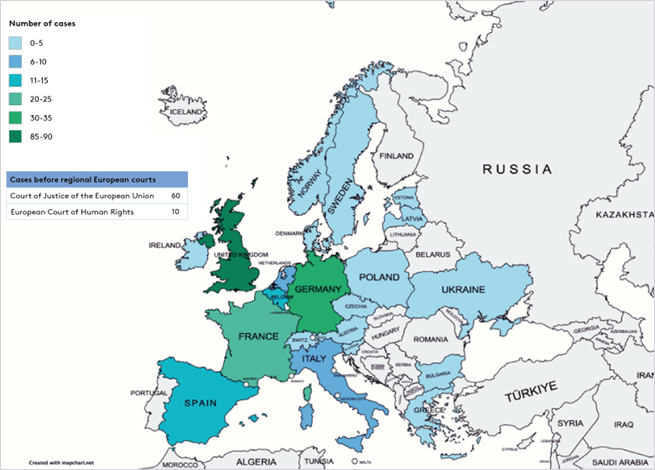Climate litigation in Europe: a summary report for the European Union Forum of Judges for the Environment

Download
Around the world, climate litigation is being used by diverse actors as a tool to influence the outcome of climate governance. Climate litigation in Europe has emerged as a way to bring about more ambitious climate policies and actions from both governments and companies, and some European cases and decisions have been influencing litigants and courts around the world.
This report, written for the European Union Forum of Judges for the Environment (EUFJE) Annual Conference 2022, provides a synthesis of information on the current state of development of climate change litigation in Europe.
Main messages
- Climate cases have now been filed in around half of all European countries and Europe is currently the location of many of the most high-profile and innovative climate change cases and decisions around the world.
- Around 75% of European climate cases have been filed against governments (75%) with a smaller proportion against private actors (16%) – but the latter is on the rise.
- The earliest recorded cases of climate change litigation in Europe date back to the early 1990s and there are now 285 climate cases documented in 20 countries in Europe. The UK, France, Germany and Spain collectively account for more than half of the total number of cases.
- More than 60 cases have now been filed before the Courts of the European Union and at least 10 cases are pending before the European Court of Human Rights (ECtHR).
- The field of climate litigation is rich and diverse, and increasingly requires lawyers and judges to become aware of the climate change consequences of the choices they make.
- One of the key distinguishing features of the current ‘third wave’ of climate litigation is the use of human rights and constitutional law arguments. Additional features include the spread of litigation to new jurisdictions and the increasing diversity of institutions targeted by the litigation.
- In Europe, as in the rest of the world, strategic climate change litigation – where claimants’ motives aim to bring about some broader societal shift – has been on the rise in recent years.
- Litigation may be used by those seeking to delay climate action as well as those seeking to advance it. However, more cases in Europe to date have had direct outcomes that advance climate action (113 cases ‘favourable’ to climate action vs. 86 ‘unfavourable’).
- The main challenges to climate change litigation relate to standing (the legal right to initiate a lawsuit); the implementation and enforcement of the right to a healthy environment and other environmental law principles; and the need for greater specialisation and training in relation to climate change and climate litigation.
- Future trends in European climate litigation identified in the report include: an increase in litigation before regional and possibly domestic courts; a growing emphasis on personal responsibility; an increase in litigation connected to extreme weather; an increase in cases focusing on greenhouse gases other than carbon dioxide; and a greater focus on forests and food systems.
The report draws on three key sources of information: the ‘national reports’ provided by EUFJE members summarising developments in their domestic jurisdictions; the annual Global Trends in Climate Litigation reports published by the Grantham Research Institute; and the global climate change litigation databases maintained by the Sabin Center for Climate Change Law at Columbia University with support from the Grantham Research Institute and others.
Further details of the EUFJE Annual Conference on Climate Law and Litigation, which took place from 24-25 October 2023, can be found here.

